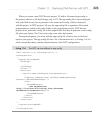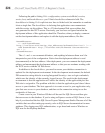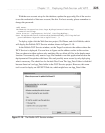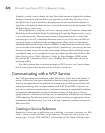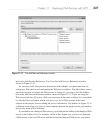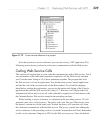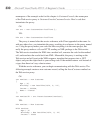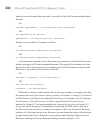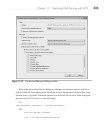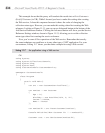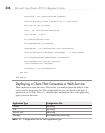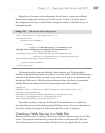
Chapter 11: Deploying Web Services with WCF 331
.Name = "Venus"
End With
Dim newCustID As Integer
newCustID = svc.InsertCustomer(newCust)
At this point, you might be wondering where the Customer type came from. As you
may recall from the previous section of the chapter that discussed custom objects, the
Customer type is a proxy type for the Customer that was defined in LINQ to SQL. Since
we set the Serialization Mode of the LINQ to SQL entity model to Unidirectional, the Web
service was able to pass the definition of the Customer with the W
eb service interface,
resulting in a Customer proxy.
To perform the insert operation, use the service proxy reference, svc, to pass the
instance of the Customer proxy. The following example shows how to get a specified
customer from the Web service:
C#:
Customer cust = svc.GetCustomer(newCustID);
VB:
Dim cust As New Customer
cust = svc.GetCustomer(newCustID)
Here, the service proxy reference is used to call GetCustomer with an ID of the requested
customer, returning an instance of the Customer proxy. The next example shows how to
update a Customer instance:
C#:
cust.Income = 49000m;
svc.UpdateCustomer(cust);
VB:
cust.Income = 49000
svc.UpdateCustomer(cust)
The cust reference in this example is the same reference that was created previously.
In this example, we are only changing the Income property. Next, we use the service
proxy to call the UpdateCustomer method, passing the Customer proxy reference. If you



